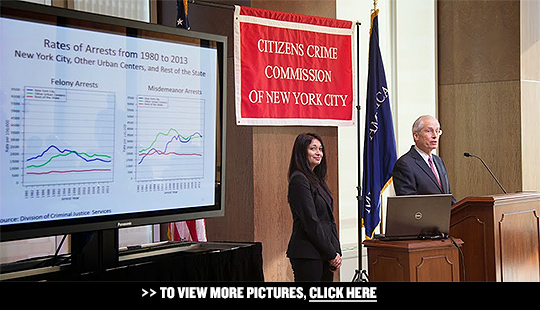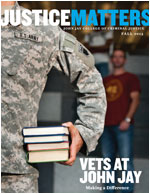Newsroom Archive
October 28, 2014, New York, NY– John Jay College of Criminal Justice President Jeremy Travis and his colleague Professor Preeti Chauhan presented key findings from their study of misdemeanor arrests in New York over the past 33 years. The presentation took place at a Citizens Crime Commission breakfast this morning.
The purpose of the study was to explore and compare trends in misdemeanor arrests from 1980 to 2013 by analyzing data from the New York Police Department, the New York State Division of Criminal Justice Services and the United States Census. This marks the first time that a comprehensive and comparative data set has been created to analyze these trends. This analysis will help frame the ongoing discussions about law enforcement and criminal justice practices regarding appropriate responses to low-level crimes.
There were four key findings from these rigorous data analyses. First, New York City – as well as other cities in New York State – experienced significant increases in the number and rate of misdemeanor arrests from 1980 to 2013. Second, young minority men have experienced the greatest increases in misdemeanor arrests in New York City. Third, there is significant variation in New York City in the kinds of charges for these arrests, their disposition and subsequent sentence, and how they are initially processed. Fourth, the increases in misdemeanor arrests are not uniform across New York City. Indeed, there is significant variation by precincts.
President Travis noted: “Taken in a historical context, these data trends represent a profound shift in our City. Crime is down to historic lows; felony arrests have dropped in half; yet the rate of misdemeanor arrests has tripled. We wanted to examine more deeply the phenomenon of misdemeanor arrests and to promote an important policy discussion about this aspect of our approach to crime and justice.”
"Of particular importance is the significant increase in misdemeanor arrests among young minority men,” added Professor Chauhan, who led the project. “Also noteworthy is the sharp decline in misdemeanor arrest rates since 2010 for the same demographic group.”
The Citizens Crime Commission hosted the event where the findings were presented to an invited audience of criminal justice practitioners, academics and law enforcement professionals. President Richard Aborn stated that “President Travis and Professor Chauhan’s research will support the ongoing important discussion about the need to consider alternatives to arrest for some misdemeanor crimes.”
The data analyses were conducted by a research team of faculty, graduate students and staff from John Jay College, with funding provided by the Laura and John Arnold Foundation.
The complete data analyses are documented in a full report entitled Trends in Misdemeanor Arrests in New York. This report will be followed by a detailed analysis of summonses, as well as a symposium on Misdemeanor Justice in 2015.
CLICK HERE for news coverage of this announcement.
About John Jay College of Criminal Justice: An international leader in educating for justice, John Jay College of Criminal Justice of The City University of New York offers a rich liberal arts and professional studies curriculum to upwards of 15,000 undergraduate and graduate students from more than 135 nations. In teaching, scholarship and research, the College approaches justice as an applied art and science in service to society and as an ongoing conversation about fundamental human desires for fairness, equality and the rule of law. For more information, visit www.jjay.cuny.edu.
About the Citizens Crime Commission
The Citizens Crime Commission of New York City is a non-partisan non-profit organization working to make criminal justice and public safety policies and practices more effective through innovation, research, and education. In the last three decades, the Crime Commission has been a leader on key issues such as: increasing the size of the NYPD, expanding the use of DNA evidence in crime fighting, creating innovations that reduce juvenile crime, developing interventions against gun violence and illegal gun crime, and highlighting the changing nature of the threat of terrorism. For more information, visit www.nycrimecommission.org.
 Inside JJC (Faculty & Staff)
Inside JJC (Faculty & Staff) Technology Services Status
Technology Services Status


